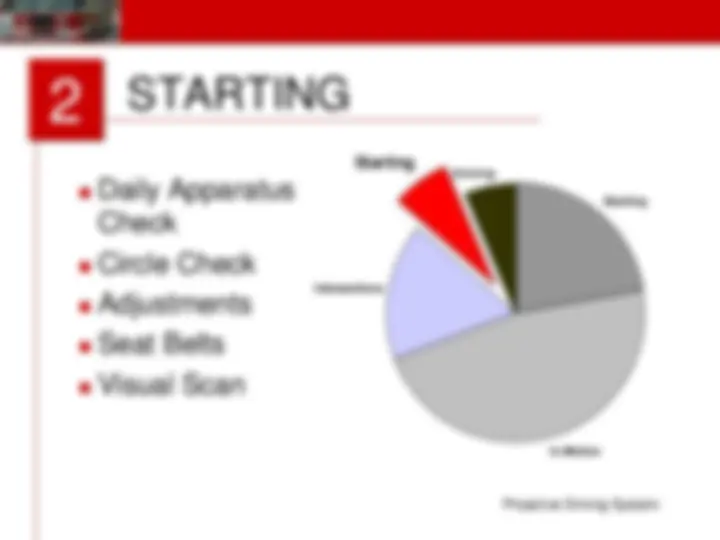


















































Study with the several resources on Docsity

Earn points by helping other students or get them with a premium plan


Prepare for your exams
Study with the several resources on Docsity

Earn points to download
Earn points by helping other students or get them with a premium plan
Community
Ask the community for help and clear up your study doubts
Discover the best universities in your country according to Docsity users
Free resources
Download our free guides on studying techniques, anxiety management strategies, and thesis advice from Docsity tutors
Montgomery County Fire & Rescue Service's Proactive Driving System aimed at reducing fleet losses. The system identifies common causes of collisions, driving tasks, and a new philosophy for proactive driving. It also covers daily apparatus checks, mirror adjustments, visual scans, seat belts, stopping distances, and eye movement.
What you will learn
Typology: Lecture notes
1 / 56

This page cannot be seen from the preview
Don't miss anything!

















































Montgomery County Fire & Rescue Service December 2002
OVERVIEW
INSURANCE
Our collision loss experience is poor
Spending money for premium increases that could be spent for more worthwhile things
Pledged to the insurer that we would improve
Insightful loss study completed
We changed the way we understand collisions
Our driving is the loss source
Our drivers are the solution
SPECIAL CAUSES
Apparatus Type Emergency vs. Non-Emergency Driving Preventability (the other driver) Shifts Districts Stations
Assigned Station vs. Detail Location of Vehicle Damage Driving Experience Multiple Collisions Time of Day Road Conditions
These Loss Factors Are Not Root Causes Of Our Fleet Losses
AT-RISK DRIVING BEHAVIORS
At-risk behaviors are simply actions that place the vehicle in harms way. The loss analysis revealed a distinct set of at-risk behaviors for each driving task. We have not made this connection in the past.
Collision reduction will occur as more operators master the driving behaviors.
10
10
10
13
13
14
15
16
22
24
25
27
33
45
49
Space Cushion M
Cover the Brake I
4 Corners Clearance I
Visual Lead Time M
Reduce Speed I
Intersection Stop I
Eye Contact I
Poor Spotter B
No Spotter B
Eye Movement I
Circle Check B
Too Fast M
Visual Scan B
4 Corners Clearance M
Eye Movement M
NEW PHILOSOPHY
We drive our vehicles with the mindset that the other driver will make a mistake in the path of our vehicle.
Our operators will drive proactively by adjusting their driving to avoid collisions triggered by other drivers, traffic, and environmental conditions.
In-Motion
Starting Arriving
Intersections
Backing
DAILY APPARATUS CHECK
CIRCLE CHECK
Compartments Ladders, tools, lights, and equipment
LDH and hose Appliances and loose equipment
Obstructions or forgotten equipment Wheel chock
VISUAL SCAN
Forward Sides Rear
Remain parked until the overhead door is 100% open
Proceed slowly through the door opening and hazard zone
E (^) T M
Fire Station
Forward
Rear
Side
Space Cushion Visual Lead Time Eye Movement Cover the Brake Safe Speed Railroad Crossings Hands Free Steering Signaling Traffic Signs & Signals
Leaving
Arriving
In-Motion
Intersections
Backing
SPACE CUSHION
for braking
or aggressive drivers
Space Cushion
STOPPING TIME
Stopping Time 4 seconds
Braking 21 / 2 seconds
Reaction 3 / 4 second
Perception 3 / 8 to 3 / 4 second
Based upon 40 mph on wet roads.
STOPPING DISTANCE
30 mph
60 mph
113 feet
315 feet
10 mph 30 feet